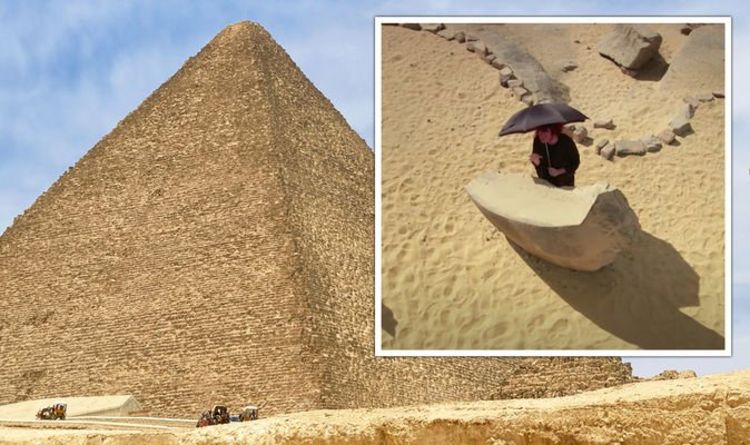Egypt: Archaeologists discover traces of pharaoh Khufu
We use your sign-up to provide content in ways you’ve consented to and to improve our understanding of you. This may include adverts from us and 3rd parties based on our understanding. You can unsubscribe at any time. More info
Known for its vast monuments, including the incredible Great Pyramid of Giza, the ancient civilisation continues to infatuate both experts and the public. Believed to have started around 3100 BC, archaeologists have uncovered evidence 700 miles south of Cairo of what is believed to be its roots. In the site of Nabta Playa, they found massive stone circles that align to the Sun and stars to mark the seasons and are thought to have been used as an ancient calendar.
But Professor Joann Fletcher detailed during Odyssey’s ‘The Story Of Ancient Egypt’ documentary why some of the rock carving uncovered could reveal more.
She said: “This has been described as Egypt’s earliest sculptured stone monument. It dates from around 5000 BC.
“This chunk of sandstone was quarried over a mile away from where it was eventually discovered.
“This certainly suggests a sense of community where people were already working together to achieve a desired aim.


“In this case, the stone was hauled into place and then there are clear signs that it’s been sculpted into a specific shape.”
The Egyptologist went on to detail what the stone carving is thought to depict.
She added: “Some believe that this is, in fact, a cow – with its large hindquarters and this sculpted head.
“Now the cow was a vital part of everyday life for these people, it was a source of meat, of milk and blood – key sources of protein to stay healthy.
“Yet, so important was the cow that they chose to take it through into the afterlife with them to sustain them on a spiritual level.

“This is the very beginnings of the great cow goddess, Hathor.”
Hathor was a major goddess in ancient Egyptian religion who played a wide variety of roles.
She was believed to be the goddess of the sky, of women, and of fertility and love.
Her cult centre would later become Dandarah, in Upper Egypt, but there were similar social groups found across Egypt and abroad.
Prof Fletcher explained why she became so important in the Early Neolithic.
She continued in February: “Hathor may have started off as a source of milk and meat, but, eventually, she would be loved and idolised by millions of Egyptians.
DON’T MISS
Germany flooding map: Where are floods in Germany? 9 dead & 70 missing [REPORT]
Biden-Merkel summit LIVE: Chancellor mocked in savage stunt [INSIGHT]
Egypt: ‘Overlooked feature’ of Tut’s mask found ancient ‘secret’ [ANALYSIS]


“She represented love, joy, beauty and motherhood.
“Although her image develops from a life-like animal to a female face with cow ears, this may be her very earliest incarnation.
“She is just one of a multitude of Egyptian gods and goddesses, they just could not get enough of them.”
The success of ancient Egyptian civilisation came partly from its ability to adapt to the conditions of the Nile River valley for agriculture.
The predictable flooding and controlled irrigation of the fertile valley produced surplus crops, which supported a more dense population, and social development and culture.
Egypt reached the pinnacle of its power in the New Kingdom, ruling much of Nubia and a sizable portion of the Near East.
During the course of its history, it was invaded or conquered by a number of foreign powers, including the Hyksos, the Libyans, the Nubians, the Assyrians, the Achaemenid Persians, and the Macedonians under the command of Alexander the Great.
The Greek Ptolemaic Kingdom, formed in the aftermath of Alexander’s death, ruled Egypt until 30BC, when, under Cleopatra, it fell to the Roman Empire and became a Roman province.
Source: Read Full Article
